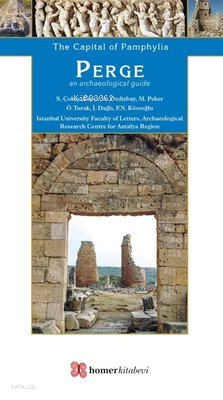9789944483995
708314

https://www.sehadetkitap.com/urun/the-capital-of-pamphylia-perge-an-archaeological-guide
The Capital Of Pamphylia Perge an Archaeological Guide
390.00
Our archaeological guides are written by well-known archaeologists in the hope that they might evoke the spirit of these sites for anyone interested in the remains of Anatolian civilizations. Illustrated with beautiful photographs, equipped with helpful plans and drawings, they are essential resources for travelers in Turkey.Perge is located in the modern Aksu district, approximately 18 km northeast of the Antalya city centre. The region covering Perge was called Pamphylia (land of all tribes) in antiquity which was bordered by Pisidia and theTaurus Mountains from the north and the Mediterranean Sea from the south. It approximately covers the present-day Antalya plain.The earliest evidence of humans in the city were found in the Acropolis indicates Late Neolithic-Chalcolithic Age. In addition, finds from the Late Chalcolithic, Early, Middle and Late Bronze Ages were also unearthed. During the Hellenistic Period, the settlement expanded towards the plain to the south of the Acropolis. Most of the structures visible on the surface of the city belong to the Roman Imperial Period which was its heyday.The excavations in Perge in 1946, initiated by Ord. Prof. Dr. Arif Müfid Mansel on behalf of the Istanbul University, were also the beginning of the first systematic Turkish excavation in the field of ClassicalArchaeologyinTurkey.AfterMansel'sdeath,Prof.Dr.Jale İnan continued the excavations.The book you are holding is prepared by the students of late Prof. Dr. Haluk Abbasoğlu, who continued the Perge excavations on behalf of the Istanbul University as the third excavation director. Perge excavations are currently carried out by Prof. Dr. Sedef Çokay Kepçe on behalf of Istanbul University. We hope that this guide, written by scholars who participated in the Perge excavations within their expertise to provide accurate information to the guests of the city, would be helpful to its users. We strongly recommend that you enrich your Perge trip by visiting the Antalya Archaeological Museum.Visitors of the city will get to know Perge better after visiting the Antalya Archaeological Museum, where a large number of artefacts found in the excavations are exhibited.
Our archaeological guides are written by well-known archaeologists in the hope that they might evoke the spirit of these sites for anyone interested in the remains of Anatolian civilizations. Illustrated with beautiful photographs, equipped with helpful plans and drawings, they are essential resources for travelers in Turkey.Perge is located in the modern Aksu district, approximately 18 km northeast of the Antalya city centre. The region covering Perge was called Pamphylia (land of all tribes) in antiquity which was bordered by Pisidia and theTaurus Mountains from the north and the Mediterranean Sea from the south. It approximately covers the present-day Antalya plain.The earliest evidence of humans in the city were found in the Acropolis indicates Late Neolithic-Chalcolithic Age. In addition, finds from the Late Chalcolithic, Early, Middle and Late Bronze Ages were also unearthed. During the Hellenistic Period, the settlement expanded towards the plain to the south of the Acropolis. Most of the structures visible on the surface of the city belong to the Roman Imperial Period which was its heyday.The excavations in Perge in 1946, initiated by Ord. Prof. Dr. Arif Müfid Mansel on behalf of the Istanbul University, were also the beginning of the first systematic Turkish excavation in the field of ClassicalArchaeologyinTurkey.AfterMansel'sdeath,Prof.Dr.Jale İnan continued the excavations.The book you are holding is prepared by the students of late Prof. Dr. Haluk Abbasoğlu, who continued the Perge excavations on behalf of the Istanbul University as the third excavation director. Perge excavations are currently carried out by Prof. Dr. Sedef Çokay Kepçe on behalf of Istanbul University. We hope that this guide, written by scholars who participated in the Perge excavations within their expertise to provide accurate information to the guests of the city, would be helpful to its users. We strongly recommend that you enrich your Perge trip by visiting the Antalya Archaeological Museum.Visitors of the city will get to know Perge better after visiting the Antalya Archaeological Museum, where a large number of artefacts found in the excavations are exhibited.
Iyzico İle Öde
| Taksit Sayısı | Taksit tutarı | Genel Toplam |
|---|---|---|
| Tek Çekim | 390,00 | 390,00 |
| 2 | 195,00 | 390,00 |
| 3 | 130,00 | 390,00 |
| 4 | 97,50 | 390,00 |
Yorum yaz
Bu kitabı henüz kimse eleştirmemiş.





















